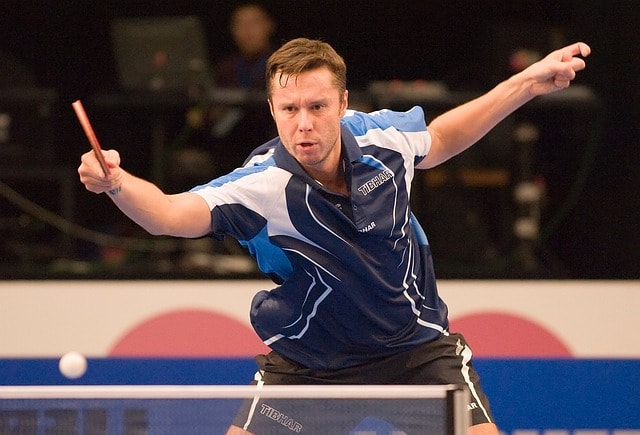Looking to understand the ping pong rule? This article breaks down the essential rules you need to know for fair and competitive table tennis play. From serving techniques to scoring, doubles play, and common rule violations, we’ve got you covered.
Table of Contents
Key Takeaways
Understanding and following the fundamental rules of ping pong, such as serving protocols and point scoring, is essential for fair and competitive play.
Serving in ping pong requires precision and adherence to strict regulations, including visible serves and specific toss heights, to maintain fairness and transparency.
Doubles matches in ping pong demand coordinated teamwork and adherence to specific serving rules, such as alternating hits and proper positioning, to ensure balanced and strategic gameplay.
Key Rules of Ping Pong

Grasping the fundamental table tennis rules is the bedrock of mastering the game. The game is played to 11 points and must be won by a two-point margin, ensuring the matches remain competitive and exciting. Matches are typically decided by the best three out of five games, adding a strategic layer to the competition.
Serving holds significant importance in table tennis, with players alternating serves every two points. However, in the event of a 10-10 tie, service alternates after every point until one player gains a two-point lead, intensifying the match’s climax. The server must stand behind the end line and toss the ball at least 6 inches straight up before striking it on the way down, ensuring a fair and visible serve.
In singles, there is no specific landing area for the serve on the opponent’s side, providing flexibility and strategic depth to the game. Each player gets two serves, alternating until one player scores 11 points, unless the score reaches a deuce at 10-10. These fundamental rules are the backbone of every competitive match, ensuring fairness and consistency across the board.
Serving in Ping Pong
Table tennis serving exceeds merely getting the ball into play; it demands accuracy and compliance with specific rules. The server must hold the ball in an open palm, toss it at least 6 inches straight up, and ensure it is visible to the opponent throughout the toss. This transparency maintains fairness and prevents any deceptive serves.
A legal serve demands the ball to be struck on its descent and land on the opponent’s side of the table. When the server fails to make a legal serve, such as when the served ball hits the net or doesn’t reach the opponent’s side, the receiver is given a point as a result. This rule encourages accuracy and fair play during the game. Common mistakes include not tossing the ball high enough or obscuring the ball’s path, both of which result in losing the point.
One unique aspect of serving is the ‘let’ serve, where if the ball hits the net but lands correctly, the serve is replayed. This rule ensures that players are not unfairly penalized for such occurrences, maintaining the game’s flow and fairness.
Therefore, a deep understanding of these rules, along with skill, is required to master the serve.
Rallying and Scoring Points
The rally commences once the serve is in play—it’s a dynamic exchange where players attempt to gain an upper hand. A legal return means the ball must bounce on the opponent’s side after being hit. If the ball touches the net but proceeds over it and lands legally, the rally continues, keeping the game exciting and unpredictable.
Scoring points during a rally can occur in several ways. If the opponent fails to make a legal return, obstructs the ball, or strikes it before it bounces on their side, a point is awarded to you. Additionally, spinning the ball can cause it to bounce back over the net after hitting the opponent’s side, scoring you a point if the opponent fails to return it.
Points can also be lost by hitting the ball into the net, out of bounds, or failing to make a proper return. Understanding these scenarios and how points are scored ensures you can capitalize on every opportunity during a rally, turning the tide of the match in your favor.
Doubles Match Rules
Doubles matches, also known as team match, add an additional dimension of strategy and coordination in table tennis, including the proper positioning of the net assembly. Partners must alternate hitting the ball during rallies, regardless of the ball’s location on the table. This alternating pattern requires seamless teamwork and communication.
Serving in doubles has specific rules:
The serve must bounce in the server’s right court and the receiver’s right court, also known as the half court.
After serving twice, teams switch places, ensuring both players get an equal opportunity to serve and receive.
This rotation keeps the game balanced and fair.
The player who served first in one game will receive first in the next game, maintaining a consistent serving order throughout the match. These rules ensure that doubles matches are not only fair but also require a high level of strategic play and coordination between partners.
Equipment Specifications

Compliance with official equipment specifications is paramount in table tennis. The standard table measures:
2.74 meters in length
1.53 meters in width
76 centimeters in height
with a net height of 15.25 centimeters
These dimensions ensure uniformity and fairness in all matches on the playing surface.
The table tennis ball has a diameter of 40 millimeters and weighs 2.7 grams, made from polymer and colored either white or orange depending on the visibility requirements. The racket’s specifications include a flat rubber surface with one side black and the other a bright color, ensuring clear distinction during play. Additionally, the table tennis net plays a crucial role in the game.
Players have the right to inspect their opponent’s racket and opponent’s playing surface before a match to understand the type of rubber used and its color. This transparency ensures fair play and allows players to strategize accordingly. Adhering to these equipment standards is essential for maintaining the integrity of the game.
Common Rule Violations
Comprehending common rule violations can help avert severe mistakes and maintain fairness. A ball hit before it bounces or into the net results in losing the point. Similarly, if the ball hits the player’s non-paddle hand during a rally, the point is awarded to the opponent.
Touching the table with any part of the body or racket during play leads to a loss of point. This rule ensures that players maintain proper form and do not gain an unfair advantage. Additionally, obstructing the opponent’s view with the body or racket incurs a point penalty.
By being aware of these common violations, players can avoid unnecessary penalties and focus on their game strategy. Maintaining adherence to the official rules ensures a fair and enjoyable match for all participants.
Special Situations
Specific instances in table tennis like edge balls and let serves imbue the game with an unpredictability factor. An edge ball, where the ball contacts the top edge of the table and bounces sideways, is considered valid and can change the momentum of a rally.
A serve that touches the net but lands correctly is known as a ‘let’ serve and is replayed. This rule prevents players from being unfairly penalized for net interference. The expedite system, initiated if a game exceeds 10 minutes with fewer than 18 points scored, ensures matches progress efficiently. Under this system, players serve for one point in turn, and the server must win the point before the opponent makes 13 consecutive returns.
These special situations add complexity and excitement to the game, requiring players to adapt quickly and maintain focus.
Inclusive Rules for Disabled Players
Table tennis promotes inclusivity by ensuring fair competition and enjoyment for disabled players. Modifications to equipment and playing styles accommodate various disabilities, allowing for a more inclusive sport. For example, players with physical disabilities affecting their arms may use adapted rackets.
In wheelchair table tennis:
Players must remain seated in their chairs
They are allowed two bounces of the ball on their side of the table
The playing area must be large enough to allow wheelchair players to move freely, ensuring fair competition.
These inclusive rules of table tennis promote fair play and ensure that all players, regardless of their physical abilities, can enjoy and compete in table tennis, even at prestigious events like the Olympic Games and USA Table Tennis competitions.
Code of Conduct
The code of conduct in table tennis underscores the importance of sportsmanship, respect, and decorum. Players are required to behave respectfully toward opponents, officials, and the sport itself, reflecting the values of the game. At the end of a match, shaking hands with opponents, umpires, and coaches is customary and shows respect.
Honesty about points is crucial; acknowledging an opponent’s shot that barely nicks the table is a key aspect of sportsmanship. Unsporting behavior, such as abusive language or throwing the racket, can lead to penalties, warnings, or disqualification. Players should apologize by lifting their index finger when winning a point due to an accidental net or edge shot.
Adhering to the code of conduct ensures that table tennis remains a respectful and enjoyable sport for everyone involved.
Checkout Official Rules of Table Tennis.
Summary
In conclusion, mastering the rules of ping pong is essential for both casual and competitive players. From understanding the key rules and serving techniques to navigating special situations and adhering to the code of conduct, each aspect of the game contributes to a fair and enjoyable experience.
By following these guidelines, players can enhance their skills, avoid common pitfalls, and ensure that every match is played with integrity and respect. Remember, the true spirit of table tennis lies in the joy of competition and the respect for your opponents.
So, next time you step up to the table, bring your best game and a thorough understanding of the rules. Happy playing!
Frequently Asked Questions
Is ping pong played to 11 or 21?
In table tennis, a game is played until one player scores 11 points or there is a 2 point difference after reaching 10 points. The rule was changed from playing until 21 in 2001.
What is the proper way to serve in ping pong?
To serve in ping pong, hold the ball in your open palm, toss it at least 6 inches straight up, and strike it on the way down while keeping the ball visible to your opponent throughout the toss. This is the proper way to serve in ping pong.
How is a point scored in table tennis?
A point is scored in table tennis if the opponent fails to make a legal return, obstructs the ball, or strikes it before it bounces on their side.
What are the dimensions of a regulation table tennis table?
A regulation table tennis table measures 2.74 meters in length, 1.53 meters in width, and 76 centimeters in height, with a net height of 15.25 centimeters.
What happens if a player touches the table during play?
You will lose a point if you touch the table with any part of your body or racket during play.









